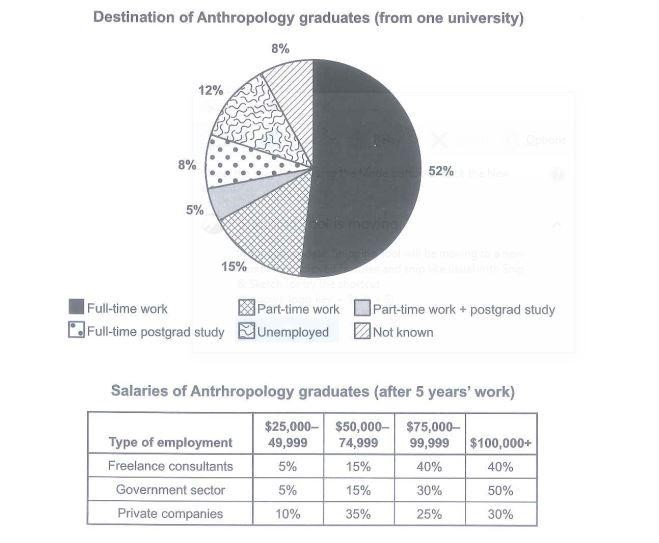The chart below shows what Anthropology graduates from one university did after finishing their undergraduate degree course. The table shows the salaries of the anthropologists in work after five years.
Summarise the information by selecting and reporting the main features, and make comparisons where relevant.

The circular chart illustrates the first line of work of Anthropology pupils after graduation and the table presents their salaries pursuing 5 years of job in various sectors.
Overall, most graduates took full-time occupation, followed by part-time work, jobless, full-time postgraduate study or unknown, and also part-time work along with postgraduate study. The average salaries were much higher for freelance consultants than those working in the government and private companies, though there were many federal workers in the highest-paid category.
At the fleeting glance, 52% of graduates were working full-time, as compared to 15% doing a part-time job, 12% were unemployed, 8% were categorised as unknown, 8% were engaged in full-time higher education and finally, 5% did part-time work combined with higher studies.
Moving to the table, freelance advisors were overpoweringly hired at higher pay scales at 40% in both salary ranges of $75,000 – $99,999 and $100,000+ with just 20% earning between $25,000 and $74,999. Furthermore, government employees exhibited a widely identical pattern to the freelance consultants at the two lowest pay bands, 30% of them were seen making between $75,000 to $99,999 range, and 50% made over a hundred thousand dollars annually. Moreover, 10 % of graduates working in private companies were drawing $ 25000-49,999, whereas the ones earning between $50,000-74,999 were 20 % more than them. Exactly a quarter of total employees working in the private sector were making $74,999 -99,999 and those who acquired the highest salary package were recorded 30%.
Vocabulary:
freelance: self-employed
fleeting glance: a brief look
identical: similar
